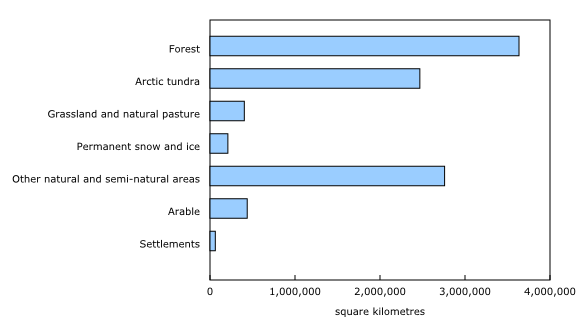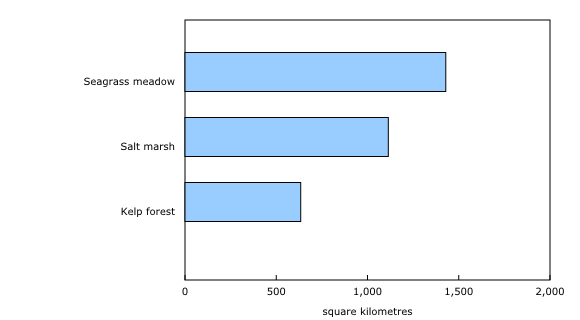Study: Accounting for ecosystem change
Archived Content
Information identified as archived is provided for reference, research or recordkeeping purposes. It is not subject to the Government of Canada Web Standards and has not been altered or updated since it was archived. Please "contact us" to request a format other than those available.
Released: 2022-01-25
The increasing severity of global environmental issues are making it clear that economic and social health are dependent on maintaining ecosystems and the flows of services that they provide. But while today's decision-making can count on a wealth of robust socioeconomic data, getting a complete picture of the state of Canada's ecosystems is difficult at the current time. Ongoing data in this area will be developed as part of the newly-created Census of Environment, which will develop information that will enable comparisons over time. These trends will help to answer several of the questions Canadians have on climate change and other environmental issues affecting their livelihoods and communities.
A new study, "Accounting for ecosystem change in Canada," is an initial attempt to account for ecosystems, providing up-to-date statistics on the extent and condition of terrestrial and marine ecosystems in Canada, as well as estimates of the supply and use of selected ecosystem services, such as food, clean air and water, and enjoyment of nature.
Canada is the second largest country in the world and among the least densely populated. Over half of the country is covered by forest and tundra, while other important areas include wetlands, grasslands, farmlands and settlements. Just under one-tenth (9%) of Canada's terrestrial ecosystems had been directly modified by humans as of 2016 for agriculture, forestry or settlement.
Over one-third of Canada is covered by forests
Over one-third of Canada is covered by boreal and temperate forest (36%). Areas harvested between 1986 and 2015 account for more than one-quarter (29%) of directly modified land. On average, about 1% of Canada's forest area was burned by forest fires or harvested each year over the period from 1986 to 2019.
In 2019, Canada's forest ecosystems supported the production of an estimated 141 million tonnes of timber. The forest sector contributed $29.2 billion towards gross domestic product in 2018.
Canada's managed forests store on average 205 tonnes of carbon per hectare. While trees take up large amounts of carbon each year, there was a net loss of carbon from managed forest ecosystems in 2018 after accounting for emissions associated with harvesting and natural disturbances.
Oceans warming and sea ice shrinking
Canada has the longest coastline in the world, and its coastal areas support a diversity of ecosystems and marine life. These areas also provide jobs and recreational opportunities to the almost 5 million Canadians living near the coast.
Changes in ocean conditions have cascading impacts on marine life and affect Canadians. Average annual sea surface temperatures have risen for most of Canada's marine ecoregions, while average sea surface salinity has decreased. The minimum arctic sea ice area has fallen by almost one-fifth (19%) on average from the 1980s to the 2010s.
The fishing and seafood sector is an important source of income for 150 coastal communities, the majority of which are located on the east coast. In 2019, 52 of 176 managed fish and marine mammal stocks were deemed healthy, while the status of 29 stocks was assessed as cautious, 25 as critical and 70 as uncertain.
Air temperatures rising the most in winter
Air temperatures are on the rise across the country. Average annual and seasonal air temperatures rose from 1948 to 2016, with the largest temperature increases occurring in the boreal and tundra ecosystems from Yellowknife to the Yukon–Alaska border. In this region, average winter temperatures have increased by more than 5°C.
On the Prairies, average annual temperatures have risen by 1.9°C from 1948 to 2016 while winter temperatures have risen by 3.8°C.
Water storage decreasing in the North
Approximately 13% of Canada's land base is covered by freshwater, including lakes, rivers and glaciers. Freshwater is also stored as groundwater and soil moisture. These freshwater assets are the source for the 36.8 billion m3 of water extracted by industries and households in 2017, excluding water use for hydroelectric generation.
Total water storage in the environment decreased in many areas from 2002 to 2016. The largest decreases occurred in northern ecozones such as the Arctic Cordillera and Boreal Cordillera where large quantities of freshwater are stored in permafrost and as snow, glaciers and ice caps.
Canada is working towards meeting targets for land and water protection. As of 2020, 12.5% of its terrestrial and inland water areas and 13.8% of its exclusive economic zone of the oceans were conserved through protected areas and other effective area-based conservation measures.
Almost two-thirds of Canada's directly modified land is used for agriculture
In 2016, 4% of the country was used for growing crops and tame or seeded pastures and just over 1% was natural pasture land. These areas accounted for almost two-thirds (64%) of directly modified land.
In 2020, Canada's agricultural ecosystems supported the production of an estimated 149 million tonnes of agricultural goods. The agriculture sector, excluding aquaculture, contributed $28.1 billion to the national economy in 2018.
Canadian cities are growing but they still account for less than 1% of the total land area
Approximately 0.6% of Canada's landscape consisted of settlement and human infrastructure in 2015, up 11% from 2000. This area represented 7% of Canada's directly modified land.
Within urban areas, trees and vegetation provide ecosystem services such as air filtration and local temperature regulation. In 2019, three-quarters of the area of population centres in southern Canada were classed as predominantly 'green' in summer (76%), while the remaining urban areas had less vegetation and were classed as 'grey'.
In 2019, 90% of households reported that they lived close to a park or public green space, while 71% of households reported having a lawn and 62% reported having a garden.
Note to readers
This report is the result of Statistics Canada's initial work to develop ecosystem accounts. Further work is ongoing to assess change on a long-term basis and develop quantitative measures and valuations to provide a more complete picture of the relationship between the economy, society and the environment and how we measure well-being and social progress.
These issues will be the focus of further efforts as we embark on the development of a new Census of Environment program, providing access to integrated environmental accounts and a wide range of regional-based information on issues stemming from rapid environmental change. Look for more of this type of analysis and engagement with key stakeholders and Canadians as the program develops over the course of the next several years.
This report focuses on available data that align with the following core ecosystem accounts:
• Ecosystem extent accounts organize data on the size and location of different types of ecosystems and their change over time.
• Ecosystem condition accounts use a number of different variables on abiotic and biotic ecosystem condition characteristics to report on ecosystem condition and how it is changing over time.
• Ecosystem services supply and use accounts report flows of ecosystem services supplied by ecosystems and used by economic units (e.g., households, industry). They provide insights on the ecosystem benefits used and enjoyed by people and which contribute to individual and societal well-being.
For more information see: Canadian System of Environmental-Economic Accounting – Ecosystem Accounts (5331).
Products
The study "Accounting for ecosystem change in Canada" is now available in Human Activity and the Environment (16-201-X).
An infographic "Accounting for ecosystem change in Canada: Selected findings from Human Activity and the Environment, 2021" is available (11-627-X).
Thematic maps related to these publications are available in "Accounting for ecosystem change, 2021" (38-20-0001).
Contact information
For more information, or to enquire about the concepts, methods or data quality of this release, contact us (toll-free 1-800-263-1136; 514-283-8300; infostats@statcan.gc.ca) or Media Relations (statcan.mediahotline-ligneinfomedias.statcan@statcan.gc.ca).
- Date modified:



